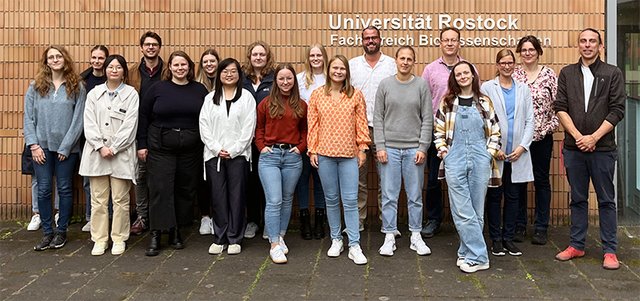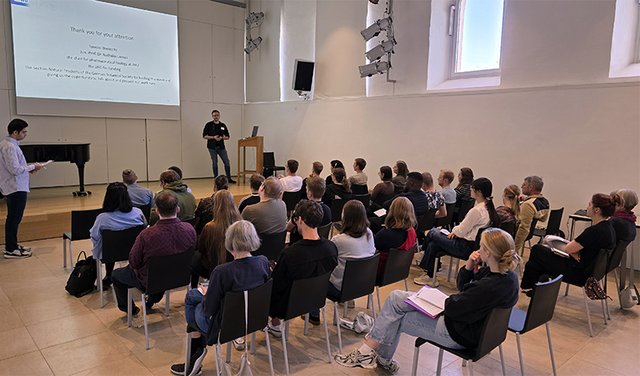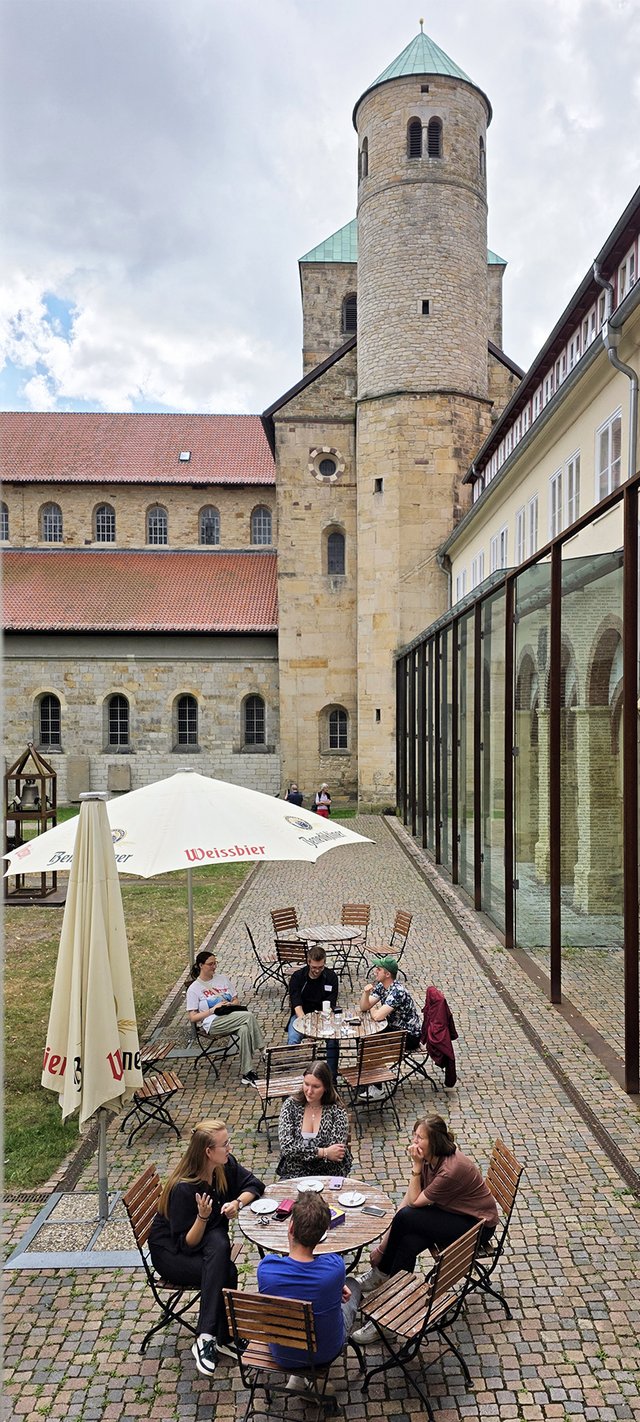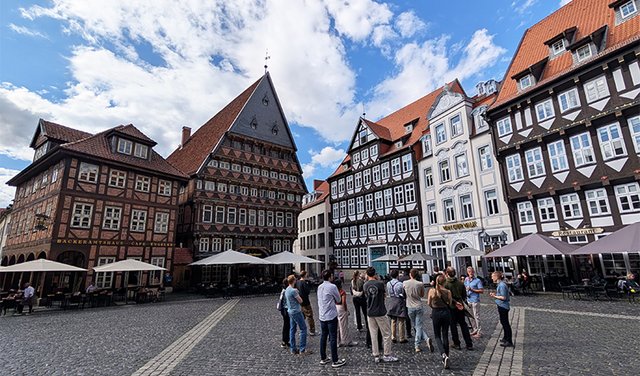The biannual Botanik-Tagung of the DBG, known as the International Conference of the German Society for Plant Sciences (DBG), has established itself as one of the most prominent interdisciplinary conferences in the plant sciences in the heart of Europe. It was in Halle (Saale) 63 years ago when the German plant science community had its last joint conference before being forcefully divided into East and West. This year’s Botanik-Tagung was held once again in Halle at the Martin Luther University Halle-Wittenberg (MLU) on 15 - 19 September and was attended by 633 participants.
The Halle region is home to many plant science institutions that collectively organized the meeting. In addition to the Institutes of Biology, Biochemistry, and Agricultural and Nutritional Sciences of the Martin-Luther-Universität Halle-Wittenberg (MLU), the Leibniz Institutes of Plant Biochemistry (IPB) and of Plant Genetics and Crop Plant Research (IPK), as well as the German Centre for Integrative Biodiversity Research (iDiv) Halle-Jena-Leipzig provided a unique constellation of expertise from the molecular to ecosystems scale. This allowed to design a programme bringing together basic plant research and applied approaches with a focus on future developments of resilient crops by new breeding methods. At the same time, current research in plant ecology and biodiversity has probably received more attention than previously in this research conference series.
The motto of the 2024 conference - Growing Solutions for Growing Challenges - reflects the fact that the plant sciences must mobilise their full potential to tackle the existential problems of our planet. Photosynthetic organisms currently offer the only way to sequester CO2 in large quantities and thus counteract climate change, but the environmental conditions in their habitats, from oceans to rainforests, are becoming increasingly unfavourable. In particular, the acceleration of climate change also requires crop plants to be adapted to limiting growth factors, which will benefit from a deep mechanistic understanding of gene and protein functions, as made possible by molecular and cell biological approaches in model plants. This scenario was reflected by the focus areas of the conference: crop improvement, biodiversity, and global change, in addition to fundamental plant research.
In his opening address, DBG president Andreas Weber pointed out the utmost importance of plants and stressed that the plant science community must leave its ivory tower and engage more extensively with society to meet the enormous challenges. Additional opening addresses were presented by Claudia Becker (Rector of the MLU), Egbert Geier (Mayor of Halle), and Karamba Diaby (Member of the German Federal Parliament - Bundestag - of the constituency of Halle). As chair of the parliamentary group on West Africa, as member of the subcommittee on global health, and as keen Halle ‘Schreber gardener’, he delivered a very personal video message. The conference opening was framed by music interludes by members of MLU‘s academic orchestra.
Opening lecture shows importance of interdisciplinary research
In his dogma-challenging opening lecture, Giles Oldroyd (Cambridge, UK) presented a novel view on the specificity of plant interactions with symbiotic mycorrhizal fungi and pathogens. Knowledge on the regulation of mycorrhization may be harnessed to improve this beneficial interaction in agricultural crop production systems, which is currently assessed in field experiments. The opening lecture thus was a prime example of translational research employing novel basic knowledge to tackle real-world challenges.
Seven plenary talks from international leading speakers
Further plenary talks presented challenges, questions, and solutions on very different levels of scale. Meredith Schuman (Zürich, CH) introduced the audience to the power of spectroscopic remote sensing, while Josep Penuelas (Barcelona, ESP) pointed out the concerning limitations of global increases in crop productivity under elevated CO2 levels. Plant responses to soil compaction were addressed by Bipin Pandey (Nottingham, UK). Sabeeha Merchant (Berkeley, USA) presented an all-embracing overview on the potential of green algae - from polycistronic RNA to their biotechnological use in producing valued human lipid mimetics. Cyril Zipfel (Zürich, CH) took us along on the search for missing pieces in immunity signalling, and Staffan Persson (Copenhagen, DK) displayed the current mechanistic understanding of cellulose synthesis, the basis of long-term carbon capture by plants. The visionary closing lecture of the conference by Keiko Torii (Austin, USA) covered the development of stomata - the pores mediating CO2 entry and water loss. Collectively, the plenary lectures, presented by internationally leading figures in their respective fields, have addressed the conference theme from diverse angles and highlighted amazing current advances in basic understanding and translational approaches.
Public lecture addressed alarming trends
In the public evening lecture, the MLU and iDiv geobotanist Helge Bruelheide informed on the alarming decline in biodiversity, affecting not only individual species, but entire ecosystems. His lecture illustrated how this diversity has changed over time, how it is affected by changes of land use and climate, and he stressed the severe consequences of biodiversity loss for the environment and the society. He also introduced the “Faktencheck Artenvielfalt”, a summary of biodiversity and its decline in Germany, which was scheduled to be published a few days later.
More than 20 Sessions addressed different topics and put ECRs on stage
The parallel sessions of the conference embraced the full spectrum of plant science. Each of the 21 sessions included a keynote lecture by an internationally renowned scientist and five short presentations selected from the abstracts submitted by conference participants. Preference was given to early career researchers (ECR), offering them a forum for high-profile scientific discussions. To accommodate a diversity of research foci, session titles were kept general and included: applied botany for food security; beneficial plant-microbe interactions; biology of algae and cyanobacteria; biotechnology and genome editing; cell biology; crop biology and genetics; gene regulation; navigating abiotic challenges; photosynthesis and general metabolism; plant development; plant hormones and chemical mediators; plant proteins: structure to function; plant systematics, evolution and biodiversity; resisting pathogens and pests; specialized metabolism.
Individual sessions were organised and chaired by the six DBG Sections, covering physiology, molecular biology, phycology, applied botany, natural products, interactions as well as biodiversity and evolution. In addition, topically focused sessions were organized by iDiv (Plant functional diversity in a changing world), the German Society of Plant Nutrition DGP (on Molecular mechanisms of plant nutrition), the DFG priority programme MAdLand (Molecular evolution of plant form and function), and the DFG research training group 2498 (Communication and dynamics of plant organelles), the latter being chaired by enthusiastic PhD students.
More than 100 talks and 400 scientific posters
Besides the 105 talks selected from the abstracts, 402 posters were on display throughout the conference and presented in two poster sessions. Part of the poster exhibition was located in the stunning historic settings of the Löwengebäude Aula, as can be seen in the gallery of conference impressions (please log in first), accessible for DBG members. Ten posters were awarded with a DBG poster prize. The difficult selection was based on ballot vote by the conference participants. An additional poster prize was awarded by the Society for Genetics. As a novelty, posters could be presented ahead of the meeting as short videos hosted on a conference YouTube channel. These very creative movies and animations produced by early career researchers raised a lot of interest.
Award-winning research by early career plant scientists
During the conference, four prizes were awarded to early career researchers, DBG's Wilhelm Pfeffer prize, DBG's Eduard Strasburger prize, DBG's Horst Wiehe prize, and DBG's Best Paper prize. The recipients of the former three awards, Henryk Straube, Eliza Loo, and Martin Lewinsky, presented their impressive award-winning research work in plenary talks to a large audience. Details about their research topics that may help future research in measuring rare DNA nucleotides, improving plant health, analysing RNA binding proteins, and looking into plant cell division is provided in the press release published a few days before the conference.
Workshops on science, outreach, and writing
In addition to the scientific programme, a number of workshops were offered to both early career and established scientists. These covered methodological aspects of plant research, plant phenotyping, experimental reproducibility, as well as complementary skills, including a workshop on self and research presentation by our editor Esther Schwarz-Weig and a plenary workshop on scientific writing and publishing by Mary Williams (Glasgow, UK), features editor and developer of the Teaching Tools in Plant Biology of The Plant Cell journal and Plantae Community Manager.
DBG’s member assembly
In the DBG general assembly meeting held during the conference, Ulla Bonas (MLU) was elected as honorary member of the Society. Professor Bonas was honoured for the ground-breaking scientific advances of her team in plant biology and plant-microbe interactions, including the elucidation of the code for DNA recognition by TAL effectors, a then novel type of DNA-binding domain. Ulla Bonas has received numerous awards and is committed to the research community as Vice President of the German National Academy of Sciences Leopoldina.
Excursions to places in the Halle-Leipzig area
After the conference, excursions were organized to outstanding plant research facilities, including the iDiv/UFZ experimental station in Bad Lauchstädt, which hosts the Ecotron, the MyDiv Biodiversity-Ecosystem Functioning Experiment, and the Global Change experimental facility; to the IPK, home of the Gatersleben Genebank and the PhenoSphere phenotyping facility; to the Canopy Crane, an iDiv ecosystem research facility in the Leipzig floodplain; and to the Halle Botanical Garden, founded in 1698.
Résumé
The 2024 conference of the German Society for Plant Biology (DBG) was a vibrant event, at which we have seen many examples of major advances in our understanding of plant sciences and in ways to adapt crops to counter a diversity of challenges. The excitement and positive spirit at the meeting were certainly promoted by the location, with the welcome reception and the exclusively vegetarian catering taking place on the picturesque “Universitätsplatz” square in mostly brilliant weather, just a footstep away from the Audimax lecture halls and the posters displayed throughout the buildings surrounding the square. Most delegates joined the Botany Party in the historic Volkspark building, where the Jazzklienten jazz band and an energetic DJ created a great atmosphere for interactions, networking, and dancing into early morning. Professional childcare was offered to allow participation of parents with children throughout the meeting, actively supported by the MLU’s family office and free of charge due to financial support by DBG and MLU.
Help and support
The conference would not have been possible without the contribution of many people that unfortunately cannot all be named here. We are particularly grateful to Julia Grimmer, coordinator of our new CRC1664, for professionally handling countless issues. The conference rested on the shoulders of many student helpers that supported catering, handled technical equipment, and prepared the poster exhibition. The conference was supported by 29 sponsors and exhibitors, introducing their newest developments in an impressive industry exhibition. Travel expenditures of international invited speakers were generously covered by the DFG, the German Research Foundation.
Subsequent early career plant researcher network meeting
After the conference, early career researchers had the opportunity to participate in a two-day Early Career Plant Researchers Network meeting with Mary Williams, David Pacheco-Villalobos (KWS, DE) and Jan de Vries (Göttingen, DE), which was organized by Sascha Laubinger (MLU) and Debora Gasperini (IPB). In this format, which also provided ample opportunities for networking, experienced PhD students and postdocs discussed topics such as inclusion and diversity in academia, career paths in academia and industry and funding opportunities. Additionally, the participants engaged in a simulated job interview for a junior professor position.
Next Botanik-Tagung
The next Botanik-Tagung will take place at Ruhr University Bochum, Germany, where Christopher Grefen and his team will welcome the plant science community from 6 to 12 September 2026. We are eagerly looking forward to this meeting and to seeing many of you again.
------
Edgar Peiter, Martin-Luther-Universität Halle-Wittenberg, Institut für Agrar- und Ernährungswissenschaften Pflanzenernährung and the local organising team of the International Conference of the German Society for Plant Sciences (DBG)

































































